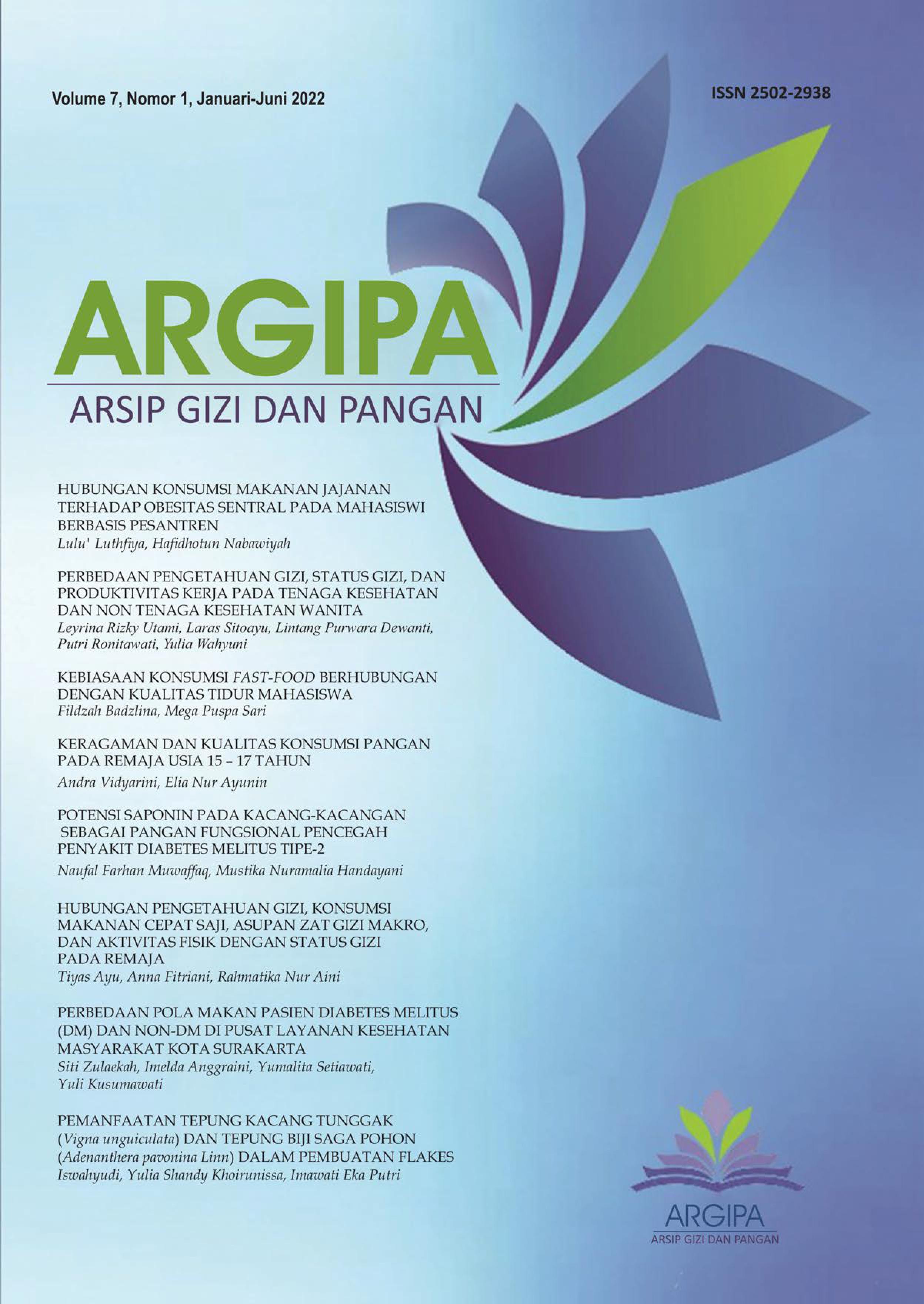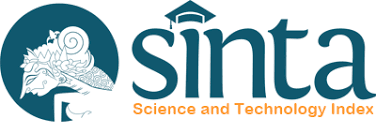The relationship of snack food consumption on central obesity in students based on islamic boarding schools
DOI:
https://doi.org/10.22236/argipa.v7i1.8087Keywords:
snack, central obesity, adolescentAbstract
The prevalence of central obesity at the age above 15 years was 31%. Adolescent girls are a group at risk for central obesity. One of the factors that influence the incidence of central obesity is the pattern of snack food consumption. This study aimed to determine the relationship between the pattern of snack food consumption including frequency, energy, and fat intake on central obesity. The study design was case control, using the OR statistical test with a 95% confidence level. The research sample was taken by purposive sampling in each group of 36 subjects, calculated using the hypothesis test for an odd ratio formula. Dietary data were obtained through interviewing using the SQ FFQ questionnaire. Central obesity data obtained by measuring the circumference of the abdomen. Data analysis used chi square test. The results of the analysis showed that there was a relationship between the frequency of snack food consumption (p = 0.013 ; OR = 6.15), energy intake of snacks (p = 0.017; OR = 5.63) and fat intake of snacks (p = 0.001; OR = 10.9) against central obesity. It could be concluded that snack food consumption pattern has an effect on central obesity.
Downloads
References
Badan penelitian dan pengembangan. (2013). Riset Kesehatan Dasar (RISKESDAS) 2013.
Emilia, E., Juliarti, & Akmal, N. (2020). Analisis Konsumsi Makanan Jajanan Terhadap Pemenuhan Gizi Remaja. Journal Of Nutrition And Culinary, 1(1).
Hendra, C., Manampiring, A., & Budiarso, F. (2016). Faktor-Faktor Risiko Terhadap Obesitas Pada Remaja di Kota Bitung. Jurnal E-Biomedik, 4, 2–6.
Jalali-farahani, S., Amiri, P., & Karimi, M. (2017). Socio-Behavioral Factors Associated with Overweight and Central Obesity in Tehranian Adults"¯: a Structural Equation Model. International Journal of Behavioral Medicine, 110–119.
Kristiana, T., Hermawan, D., Febriani, U., & Farich, A. (2020). Hubungan Antara Pola Tidur Dan Kebiasaan Makan Junk Food Dengan Kejadian Obesitas Pada Mahasiswa Universitas Malahayati Tahun 2019. Human Care Journal, 5(3), 750.
Murakami, K., & Livingstone, M. B. E. (2015). Eating frequency is positively associated with overweight and central obesity in US adults. Journal of Nutrition, 145(12), 2715–2724.
Mustain, M. (2021). Gambaran Kebiasaaan Konsumsi Makanan Cepat Saji, Minuman Ringan, Aktifitas Fisik Dan Status Gizi Pada Mahasiswa D3 Keperawatan Universitas Ngudi Waluyo. Jurnal Ilmu Dan Teknologi Kesehatan, 12(1), 14–20.
Nasution, L. K., Siagian, A., & Lubis, R. (2014). Hubungan Obesitas Terhadap Kejadian Diabetes Melitus Tipe 2 Pada Wanita Usia Subur di Wilayah Kerja Puskesmas Pintpadang. Jurnal Muaran Sains, 2(1), 240–246.
Natalia, D., Hasibuan, P., & Hendro. (2014). Hubungan Obesitas dengan Hipertensi pada Penduduk Kecamatan Sintang, Kalimantan Barat. EJKI, 2(3), 5–7.
Rahman, J., Fatmawati, I., Syah, M. N. H., & Sufyan, D. L. (2021). Hubungan peer group support, uang saku dan pola konsumsi pangan dengan status gizi lebih pada remaja. AcTion: Aceh Nutrition Journal, 6(1), 65.
Rahman Nurdin, Dewi Nikmah Utami, A. F. (2016). Faktor-Faktor yang Berhubungan dengan Perilaku Makan Pada Remaja SMA Negeri 1 Palu. Preventif, 7, 43–52.
Sari, M. K., Lipoeto, N. I., & Herman, R. B. (2016). Hubungan Lingkar Abdomen ( Lingkar Perut ) dengan Tekanan Darah. Jurnal Kesehatan Andalas, 5(2), 456–461.
Sari, Y. D., & Rachmawati, R. (2020). Kontribusi Zat Gizi Makanan Jajanan Terhadap Asupan Energi Sehari di Indonesia (Analisis Data Survey Konsumsi Makanan Individu 2014). The Journal of Nutrition and Food Research, 43(1), 29–40.
Sugiarti, L., & Latifah. (2011). Hubungan Obesitas, Umur dan jenis Kelamin Terhadap Kadar Kolesterol Darah. Jurnal Sains Naturan Universitas Nusa Bangsa, 1(0251), 73–80.

















